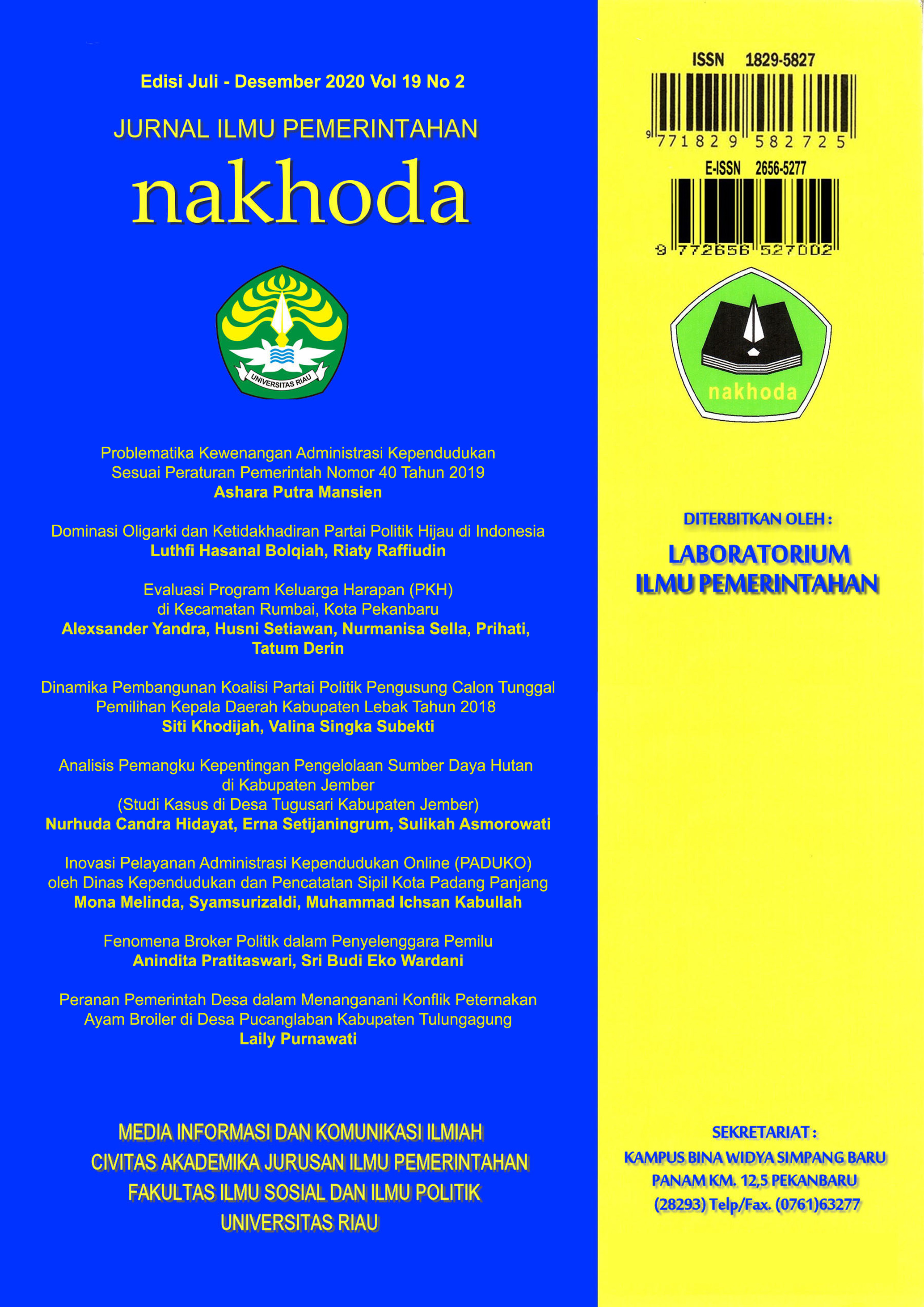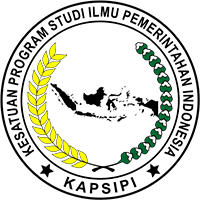The Analysis of Stakeholder Forest Resources Management in District of Jember
(The Case Study in Tugusari Village, Jember District)
DOI:
https://doi.org/10.35967/njip.v19i2.118Keywords:
Forest management, Stakeholders, Public company PerhutaniAbstract
This study aims to analyze stakeholders in forest resource management in Tugusari Village, Bangsalsari District, Jember Regency. This research is motivated by the drastic reduction of critical land in Jember Regency, or in other words, there is success in forest conservation in the period 2011-2015. In answering the problem formulation and analyzing stakeholders using a stakeholder approach with Overseas Development Administration theory to identify stakeholders. Meanwhile, for the categorization and interrelation of stakeholders using Reed's theory. This study uses descriptive qualitative method. The results of this study have identified primary, secondary and key stakeholders. The primary stakeholders were LMDH Wana Makmur and the Tugusari Village Government. Secondary stakeholders are PHW Unit VII Bondowoso Jember working area. The key stakeholder is the public company Perhutani KPH Jember. Meanwhile, the stakeholder category consists of key players, contact setters, subjects, and crowds. The key category is the public company Perhutani KPH Jember. The contract setters, namely the Village Government. Subjects were LMDH Wana Makmur and Crowd, namely UPT PHW VII Bondowoso, Jember working area. While the interrelation between LMDH Wana Makmur stakeholders and the public company Perhutani KPH Jember went well because they often held coordination meetings and collaborative involvement. Thus it can be concluded that the success of forest resource management in Tugusari Village, Bangsalsari District Jember is due to the excellent interrelation of key players and subjects.
Downloads
References
Ackermann, F., & Eden, C. (2011). Strategic Management of Stakeholders?: Theory and Practice. Long Range Planning, 44(3), 179–196. https://doi.org/10.1016/j.lrp.2010.08.001
Bryson, J. (2003). What to do when stakeholders matter?: A guide to stakeholder identification and analysis techniques.
Creswell, J. (2009). Research Design, Qualitative, Quantitative And Mixed Methods Approaches. Sage Publication.
Darmansyah, R., & Amin, R. M. (2019). Kearifan Lokal Desa Buluh Cina ( Studi Kasus Koordinasi Lembaga Adat , Pemerintahan Alam Desa Buluh Cina ). Nakhoda: Jurnal Ilmu Pemerintahan, 18(1), 35–46. https://doi.org/10.35967/jipn
Derak, M., Cortina, J., & Taiqui, L. (2017). Integration of stakeholder choices and multi-criteria analysis to support land use planning in semiarid areas. Land Use Policy, 64, 414–428. https://doi.org/10.1016/j.landusepol.2017.03.006
Fibrianingtyas, A. (2020). Sinergitas Stakeholder Dalam Pengelolaan Kelestarian Hutan Kawasan Ub Forest. Jurnal Ekonomi Pertanian Dan Agribisnis, 4(4), 973–984.
Freeman, R. A. (2010). Strategic Management: a Stakeholder Approach. Cambrige University Press.
Gibson, K. (2000). The moral basis of stakeholder theory. Journal of Business Ethics, 26(3), 245–257. https://doi.org/10.1023/A:1006110106408
Grimble, R., & Wellard, K. (1997). Stakeholder Methodologies in Natural Resource Management?: a Review of Principles , Contexts , Experiences and Opportunities. Agricultural SystemS, 55(2), 173–193.
Innes, J. E., & Booher, D. E. (2015). Collaborative policymaking: governance through dialogue. In Deliberative Policy Analysis Understanding Governance in the Network Society (pp. 33–59). Cambrige University Press.
Irawanto, D. (2013). Konstruksi Kebijakan Pengelolaan Sumberdaya Hutan Multistakeholder di Kabupaten Jombang. Jejaring Administrasi PUblik, 5(2), 343–355.
Isril, Febrina, R., & Harirah, Z. (2018). Kemitraan Pemerintah dan Swasta dalam Kebijakan Pengelolaan Sampah di Kota Pekanbaru. Jurnal Ilmu Pemerintahan Nakhoda, 17(29), 60–72. https://doi.org/10.35967/jipn.v17i29.7059
Kull, A. J., Mena, J. A., & Korschun, D. (2016). A resource-based view of stakeholder marketing. Journal of Business Research, xxx, xxx–xxx. https://doi.org/10.1016/j.jbusres.2016.03.063
Kusumedi, P., & HB, A. R. (2010). Analisis Stakeholder Dan Kebijakan Pembangunan Kph Model Maros Di Propinsi Sulawesi Selatan. Analisis Kebijakan Kehutanan, 7(3), 179–193.
Miles, M. B., & Huberman, A. M. (1992). Analisis Data Kualitatif. Terjemahan Tjetjep R.R. UI Press.
Nasir, M. (2003). Metode Penelitian. PT. Ghalia Indonesia.
Neuman, W., & Lawrence. (2015). Metodologi Penelitian Sosial: Pendekatan Kualitatif Dan Kuantitatif. PT. Indeks.
Nugroho, R. (2017). Dinamika Kebijakan Analisis Kebijakan Publik, Manajemen Politik Kebijakan Publik, Etika Kebijakan Publik, Kimia Kebijakan Publik. PT Elex Media Komputindo.
Oda. (1995). Guidance Note On How To Do Stakeholder Analysis Of Aid Projects And Programmes.
Paletto, A., Giacovelli, G., & Pastorella, F. (2017). Stakeholders’ opinions and expectations for the forestbased sector: a regional case study in Italy. Internasional Forest Review, 19(1), 68–78.
Rafi, M., Pribadi, U., & Rahmanto, F. (2020). Factors that Affect Deliberation of Maguwoharjo Village Development Planning Sub-District Depok Regency Sleman Yogyakarta. Nakhoda: Jurnal Ilmu Pemerintahan, 19(1), 91–101. https://doi.org/10.35967/jipn
Raum, S. (2018). A framework for integrating systematic stakeholder analysis in ecosystem services research?: Stakeholder mapping for forest ecosystem services in the UK. Ecosystem Services, 29, 170–184. https://doi.org/10.1016/j.ecoser.2018.01.001
Reed, M. S., Graves, A., Dandy, N., Posthumus, H., Hubacek, K., Morris, J., Prell, C., Quinn, C. H., & Stringer, L. C. (2009). Who ’ s in and why?? A typology of stakeholder analysis methods for natural resource management. Journal of Environmental Management, 90(5), 1933–1949. https://doi.org/10.1016/j.jenvman.2009.01.001
Rusli, B. (2013). Kebijakan Publik Membangun Pelayanan Publik yang Responsif. Halim Publishing.
Salam, A., & Noguchi, T. (2006). Evaluating capacity development for participatory forest management in Bangladesh ’ s Sal forests based on d 4Rs T stakeholder analysis. Forest Policy and Ekonomics, 8, 785–796. https://doi.org/10.1016/j.forpol.2004.12.004
Schmeer, K. (1999). Stakeholder Analysis Guidelines. In Stakeholder Analysis Guidelines (pp. 2–32).
Singarimbun, M., & Effendi, S. (2008). Metode dan Proses Penelitian. LP3ES.
Siswoko, B. D. (2009). Good Forest Governance: Sebuah Keniscayaan dalam Pengelolaan Sumber Daya Hutan Lestari. Jurnal Ilmu Kehutanan, 3(1), 1–12.
Weible, C. M. (2006). An Advocacy Coalition Framework Approach to Stakeholder Analysis?: Understanding the Political Context of California Marine Protected Area Policy. Journal of Public Administration Research and Theory, 95–117. https://doi.org/10.1093/jopart/muj015
Widodo, M. L., Soekmadi, R., & Arifin, H. S. (2018). Analisis Stakeholders Dalam Pengembangan Ekowisata Di Taman Nasional Betung Kerihun Kabupaten Kapuas Hulu. Jurnal Pengelolaan Sumberdaya Alam Dan Lingkungan, 8(1), 55–61. https://doi.org/10.29244/jpsl.8.1.55-61
Zubayr, M., Darusman, D., Nugroho, B., & Nurrohmat, D. R. (2014). Peranan para pihak dalam implementasi kebijakan penggunaan kawasan hutan untuk pertambangan (. Jurnal Analisis Kebijakan Kehutanan, 11(3), 239–259.
Downloads
Published
How to Cite
Issue
Section
License
Copyright (c) 2020 Author(s)

This work is licensed under a Creative Commons Attribution-NonCommercial-ShareAlike 4.0 International License.





